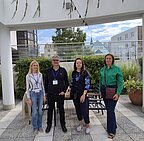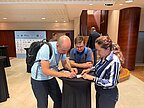Regular Partners’ Meeting for project implementation monitoring (November, 25th 2024)
The partners of the ESCULAPE project held a regular meeting to monitor the project's implementation, review progress, and discuss key developments.
The meeting opened with a review of ongoing activities, focusing on the implementation of work packages and the achievement of planned milestones. Partners shared updates on their respective tasks, highlighting successful outcomes and addressing any challenges encountered. These discussions allowed for the identification of areas requiring additional attention to ensure alignment with project goals.
The results of the electrical characterization (electroconductivity) of the electrospun mats, measured using methods of impedance spectroscopy, were discussed during the meeting. Key findings highlighted the mats' conductivity levels and their potential implications for the intended applications, providing valuable insights into their performance and optimization needs.
In conclusion, the meeting served as a productive forum for monitoring project implementation and strengthening partner coordination. The discussions reaffirmed the partners’ commitment to achieving the project’s objectives and provided a clear path forward for the next phase of activities.
The meeting focused on the progress of project work package tasks, with discussions on electrospinning techniques, material characterization, and electrical properties of fabricated membranes.
Electrical impedance tomography (EIT) measurements were conducted on MXene samples to evaluate changes in their electrical conductivity after dip coating. The collected data was analyzed, and computational methods for solving the EIT inverse problem were further developed and refined to enhance accuracy in conductivity mapping.
Aleksi Kuivisto from UEF presented the electrical characterization of electrospun mats, emphasizing the assessment of their electroconductive properties. He described a specialized experimental setup utilizing Keithley instruments for precise measurements. The four-probe method was employed to ensure accurate conductivity evaluation, minimizing contact resistance effects.
These investigations contribute to understanding the conductive behavior of MXene-integrated electrospun mats, which is crucial for their potential applications in biomedical sensors, smart textiles, and tissue engineering scaffolds. Future work will focus on refining measurement techniques and optimizing MXene incorporation to enhance electrical performance.
Series of scientific meetings were held as part of the MXene Symposium within the framework of the NAP 2025 conference in Bratislava, Slovakia, September 7–12, 2025, to summarize the conclusions and results of the first project period. The discussions focused on assessing the level of scientific achievements in line with the objectives of the work packages, evaluating the success of the secondments, and defining plans for the second project period, including optimizing implementation and execution based on the experience gained during the first stage.
The ESCULAPE project partner teams, Maksym Pohorielov and Viktoriia Korniienko (University of Latvia), Oleksiy Gogotsi and Veronika Zahorodna (MRC, Ukraine), Arunas Ramanavicius and Almira Ramanavičienė, Anton Popov (Vilnius University), Igor Iatsunskyi (Adam Mickiewicz University), Albano Meli (INSERM, France), Sanjiv Dhingra (University of Manitoba) and Sergiy Kyrylenko (Sumy State University) - together with PhD candidates and students, contributed with presentations and discussions on MXene-related research carried out within the project.

 CONFERENCE
CONFERENCE



